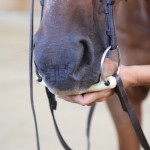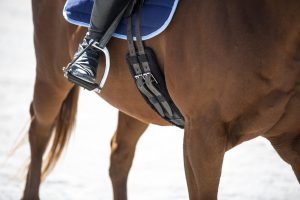The title to this post is a bit misleading as the answer to most problems where people begin considering a “bigger bit” is not to change the horse’s mouthpiece but instead to reconsider the horse’s training.
Problems like head tossing, pulling, rooting, or rushing may initially seem as though they could be fixed by simply using a bit with a harsher mouthpiece or more leverage, but while it may work temporarily a more severe bit often ends up making the problem worse in the long run.
Watch the video below to learn more:














22 Responses
Great post. I just decided to go the other way: put a softer french bit so I could be more nuanced on my forward horse. I will save the “bigger bit” for when/if we ever go on trails, but for the arena I prefer to sharpen my reading and fine tune my contact. Thanks for a great post-as usual.
I noticed with the school horse I ride no amount of pulling is going to stop him, (which I do not pull hard on the reins) my trainer is trying to teach me to redirect his energy so he doesn’t learn he gets what he wants by pulling away and he has to keep thinking about what he is doing.
Thank you for this. I couldn’t agree more. I go to a horse event every year and see thousands of harsh bits. It makes me upset because I realize it’s the rider who needs to do better training. I ride both my horses in a very mild bit. And I had to train a hot, previously mistreated, thoroughbred not to rush or pull or shake his head and it was all done with CALM slow training. I use a calm low voice, or slow my body down – like post slower to slow my horse down. I would never have achieved the nice relationship I have with this horse by pulling on the reins or using a bigger or harsher bit. Thank you again for your spot on training.
Love the quote you referenced by Elwin Edwards. It does take 2 to pull! Horses must be taught to “give” to bit pressure, not push into it. It is natural for horses to push into pressure so teaching horses to give or yield to it should be a fundamental (and VERY important) exercise taught early on in a horse’s training. Teaching this skill should be taught with the horse “in hand” wearing a halter and can be started as early a foal’s first week. Yielding or giving to pressure is so necessary in all aspects of horsemanship. If we cannot ask the horse to easily and willingly move its 5 body parts (head and neck, shoulders, rib cage, and hind quarters) we cannot expect our horse to be soft and supple when being led or ridden. Yielding to the bit (included in yielding the head and neck) is what gives the horse and rider the finesse (and, of course, better control) to bring about the relaxed, calm and willing partner we all love to ride and handle! Softness is key to a happy horse and happy rider/handler! No “Tug of Wars” should be allowed! Enjoy the ride!
This was very well designed. I like that you thought about there may be another problem with the horses mouth. Or another rider may have thot him to do what he is doing
Hi Callie, I really enjoy your videos! I have a question related to this. My friend’s horse keeps biting his bit. I asked her about it and she say’s he’s been doing that all his life (she trained the horse herself). I was wondering what might cause this behavior and how it might be corrected? Thanks and greetings from the Netherlands!
Hi Allard,
Most of the time chewing or mouthing the bit is out of anxiety… so the solution would be more about changing the emotion than preventing the actual mouthing behavior
How do you change the horses emotion, I too have a mare that “chomps on the bit and is a head shacker”
Again I think it’s just her getting worked up
It is worse on the trail than in the arena
She’s is getting better but we have a ways to go
I use a kimberwick always ?
Anything you can suggest Callie
Thanks from Canada
Communication should begin on the ground and in the seat, not in the mouth. A rider who uses their seat properly and effectively shouldn’t have to pull on reins. My horse does everything through seat not reins even on the trails.
Callie , can you make a video to discuss different types of bits, their leverage and function and what types of riding they are best used for. It can be really overwhelming to look at the bit displays at the tack shops. I see the types with copper parts, rollers, plastic, twists, elevations, you name it…i just wonder who uses what and why? I use a simple French link for my mare, recently switched from a plain snaffle. I try to stay simple and as little severity as possible. But I wonder, would my horse be happier with something else? I am afraid to try anything without knowing what the purpose is. Thanks!
Yes, please. I did the same and went from a snaffle to a french bit, hoping my horse would be less reluctant when briddled. It seems to work, but I need more pressure to get him on the bit, so not sure it’s ideal. I would still put a bigger bit for going outside the arena, because he can be forward and spooks a fair bit, but am not sure which one.
Hi Karen, Thanks for the suggestion!
Thanks for the suggestion!
Yes, this would be a great topic – I had made an old video on this, but a remake is probably in order
All I can say is- Ride with your seat not your hands!
Callie, in supplement to Karen’s request, might you include how to properly measure bit length? I’m not certain which length to choose when given the option for 5″ or 4.75.”
Thanks
I’m going to link to this article from Dover: http://www.doversaddlery.com/how-to-measure-for-a-bit-page-1/a/489/
I start young horses on snaffles with copper rollers, when you are teaching them to seek contact and get their heads down, the rollers encourage them to work on the bit, and the copper stimulates saliva. Nice soft, seeking, wet mouth! Any bit that encourages the head to come up and the spine to hollow is too harsh, so encourage the horse to seek contact, round his spine and engage the hind end. You ride the whole horse, so the bit is only a small part of overall lines of communication, but it can certainly cause long standing problems in your relationship with the horse, and his fitness and health.
As usual, Callie another great video! I appreciate your perspective on using a larger bit. My trainer has me using a snaffle bit in the arena for bending, circling, one-rein stops, etc. She thinks I’m safer trail riding in groups with a shank bit, as she says… you need better BRAKES OUT THERE! Ha Ha! So, I have been doing just that for a long time. My Mustang is a rescue from the BLM, I’ve been working with her for 5 yrs, she is coming along beautifully due to taking my time and not pushing or rushing her & remaining calm and practice, practice, practice. The other day my friend & I went for a trail ride, I felt my horse was being nice & soft so, decided to use the snaffle bit on trail, half way through the ride My friend asked, how’s the bit doing?? I had totally forgot I was using the snaffle bit!! Wow! I’m so proud of her, she’s come along way! And I guess I have too. Thanks again for your inspiration Callie!
You’re welcome Suzanne! Thanks for your comment!
Hi Callie, thanks for another good video. I completely agree and am currently in the process of backing 20+ horses although thankfully most of them are done now! None of them pull and I can ride any of them bit-less and some are just much happier without a bit in their mouths. My question to you is, in your video you mentioned thinking about what the horse has been taught to do in response to bit pressure. Now, I may perhaps have the opposite problem to most people who’s horses pull hard, or perhaps this is where many people go wrong… My horses are all light on the bit and will respond to bit pressure by slowing down, as I’ve taught them. It is coming time to teach them to soften and actually take up a little bit of constant pressure so that we can have a contact. Many of them respond by slowing and I’m just wondering how the horse actually learns how much pressure is “contact” and how much pressure is “slow down?” Does that question make sense? It feels like I’m de-training my “slow” response as they learn to take up a contact. Is it just a matter of very very precise timing and knowing what level of pressure means what. It seems like it must be very confusing for the horse…
Petra;
Remember, horse communication happens through our body language. Our seat, when riding is, in my opinion, the most important aid to communicate our wishes to our horse. If our body (through our seat) still has life and energy the horse should keep its life and energy, and if we “quit riding”…turn off or slow our energy (depending on what you are asking) the horse should “FEEL” the difference and respond accordingly. This is primarily what allows us to ride bridleless. I actually wonder why people think they need to ride on contact if the horse responds to softening to contact/pressure by giving his body part/s to you… whether it’s his head and neck (through his poll,vertically,or bending laterally), or his shoulders, ribcage,or hindquarters. If the horse slows when you take up contact, try to keep energy in your seat and think “go forward” as opposed to “slow down or stop”.
Was it Sally Swift? who advocated that you “Ride with your mind”. (sorry if I’m giving credit to the wrong person!). Hope this will help. Good luck with your training.
This is a great question Petra! I feel that contact, when trained correctly, does not come from the rider but from the horse. As the horse progresses in their training and develops rhythm, then suppleness through the back (being able to stretch and bend), then impulsion from the hind end, they will begin to actually reach for the contact themselves as they stretch forward with the neck. It remains very light and soft, but the horse can hold it comfortably when they working with a loose back and neck. Does this make sense?
I’m always thankful that you give all the reasoning behind what seems like the more gentle approach with horse behaviors. As a beginner, Its been helpful to learn how my mistakes affect the horse ; and it’s definitely changed how I behave towards it.